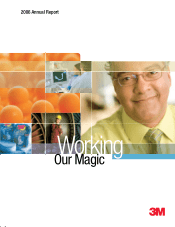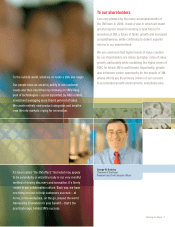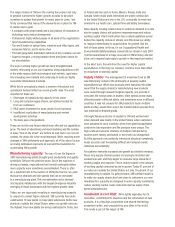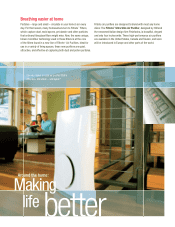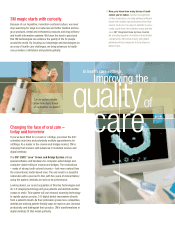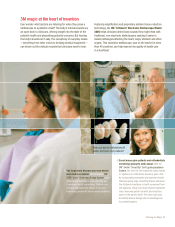3M 2006 Annual Report Download - page 4
Download and view the complete annual report
Please find page 4 of the 2006 3M annual report below. You can navigate through the pages in the report by either clicking on the pages listed below, or by using the keyword search tool below to find specific information within the annual report.The major mission of 3M over the coming few years is not only
to position ourselves for higher growth, but also to structure
ourselves to sustain that growth for many years to come. I am
firmly convinced that many of the elements are in place for 3M
to realize such a goal:
•A company with great brands and a long history of innovation in
technology and product development
• Professional, highly skilled people in all parts of the organization
•Great manufacturing capabilities
•The world leader in optical films, industrial and office tapes, and
nonwoven fabrics, just to name a few
•The best geographic distribution network of any company our size
•Superior margins, a strong balance sheet and great returns for
our shareholders
The keys to driving higher growth are fairly straightforward,
namely, refocusing on our core business, using acquisitions to fill
in the white spaces (both technological and market), rapid entry
into emerging new markets and continuing to build our highly
successful international business.
While this is conceptually simple, a number of structural and
operational factors limited our recent growth rates. The most
important of these are:
1. Shortages of manufacturing capacity in key areas
2. Long and complex supply chains, sometimes located far
from our customers
3. R&D under-investment in some areas of core business
4. Insufficient localization of manufacturing and market
development activities
5. The slow pace of acquisitions
These are not the only factors which have affected our capability to
grow. The level of advertising and merchandising and the number
of sales “feet on the street” are factors as well. But in our current
context, the above list is the most important. While requiring some
changes in 3M’s philosophy and approach, all of the above factors
are being addressed vigorously as we build the foundation for
accelerating 3M’s growth.
Manufacturing capacity: The use of Lean Six Sigma in
3M’s manufacturing plants brought great productivity and quality
benefits to 3M over the past few years. But in the euphoria of
driving out waste, expectations that it would continually deliver
more capacity were sometimes overestimated. There is, after
all, a practical limit to the number of shifts that can be run, yield
that can be obtained and line speeds that can be increased
in a manufacturing plant. This overestimation led to demand
and capacity imbalances, with the largest divergence naturally
emerging in those businesses with the highest growth rates.
Today, we are vigorously investing in manufacturing capacity
to respond to unmet higher demand. 3M currently has under
construction 19 new plants or major plant extensions. All the new
plants are outside the United States, where our growth rates are
the highest. Four new plants are being constructed in China, two
in Poland and one each in Korea, Mexico, Russia, India and
Canada. Seven major plant extensions are under construction
in the United States and one in the U.K., principally to meet new
demand in our health care, optical films and safety businesses.
New capacity is being located close to customer demand to create
shorter supply chains, aid customer responsiveness and reduce
working capital. Plant construction has a natural gestation period
before the capacity comes on stream, and this slows our ability
to respond immediately to opportunities for growth. But the
first of these plants (in Korea, for our Occupational Health and
Environmental Safety business) comes fully on stream in July 2007.
It is the fastest build of a major new plant in 3M’s history and will
allow us to respond vigorously to growth in this important market.
In the short term, this will drive the need for higher capital
expenditures. In the long run, however, it will be more than offset
by reductions in working capital.
Supply chains: The management of investment risk at 3M
was historically rooted in the philosophy of keeping capital
expenditures low. When new products were launched, this often
meant that the supply chains for manufacturing new products
were routed through unused marginal capacity, one process in
one plant, the next process in another, often spread across many
different plants in different states, and sometimes even in different
countries. It was not unusual for 3M products to touch multiple
plants as they wound their way in the transformation process from
raw materials to finished goods.
It brought fabulous returns on capital for 3M and worked well
when demand was mostly in the United States, when customers
were prepared to carry inventory, when inter-plant transportation
costs were less expensive and the products were unique. The
high costs and resource intensity of multiple manufacturing
touches were mostly overlooked or were seen as unimportant.
But this approach concomitantly introduced structural complexity,
made accurate cost forecasting difficult and reduced overall
individual accountability.
As customer demands increased and growth accelerated overseas,
these long supply chains became increasingly stretched and
worked less well, and they began to consume large amounts of
working capital and expense. This is clearly evident in the amount
of working capital consumed as we’ve grown. Today 61 percent of
our sales are outside the United States, but only 35 percent of our
manufacturing is outside. So going forward, 3M’s default model is
to make our supply chains short and close to customers: our new
investments in capacity are designed to solve capacity constraints,
reduce working capital, lower costs and improve supply chain
speed simultaneously.
Investment in core R&D: 3M is rightly legendary for its
innovation, commitment to invention and the introduction of new
products. It is a fabulous cooperative and shared-technology
ecosystem unlike, and unequaled by, any other in the world.
This really is part of the magic of 3M.

